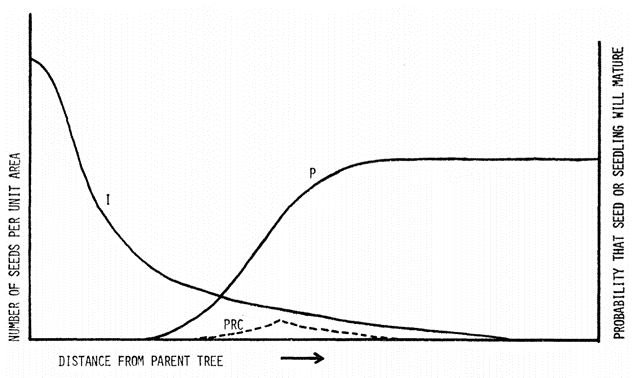Last week, I left my hometown in southern France to settle in the Neotropics for the year to come. Being back in Panama for the first time since 2014 felt like returning to an old friend, a home away from home. But as we begin our Integrative Tropical Biology Course, I have found myself pondering not only my own transiting around the globe, but also that of the organisms that compose the world’s tropical ecosystems. Young plants, too, disperse away from their parent in order to make a living in a new location. What drives seedlings away from their parent tree? Are there consequences of this dispersion for the composition of the world’s tropical forests?
The first week of the course brought us to Barro Colorado Island (BCI), one of the Smithsonian Tropical Research Institute (STRI)’s most iconic field stations. As I walked the trails of this forest that I used to be acquainted with, I quickly found that – as I had expected – I could only name but a few of the tree species I once knew. There was something both disappointing and truly amazing about my inability to recognize the plants surrounding me. There were simply more species there than I could recall in detail. On BCI, there are over 300 woody plant species in 50ha of forest alone (Condit 1998, Condit et al. 2012, Hubbell et al. 1999).

BCI is not only floristically diverse, the island also hosts a variety of animal species. Some of our encounters during our time on BCI include howler monkeys, colorful frogs, azteca ant nests, and a hemipteran nymph. Photo credits: Chloé Debyser.
Like many lowland tropical forests around the world, BCI’s plant community is composed of a few very abundant tree species and a multitude of rare plant taxa (Condit 1998, Condit et al. 2012, Hubbell et al. 1999). It is not uncommon for one to walk several hundred meters on BCI without ever encountering two individuals of the same species. Yet, each individual tree once originated from a seed produced by a parent tree, by necessity a tree of its own species. So why do so few adult trees occur in close spatial proximity to other individuals of their species, such as their parent or their “siblings”? Why do trees tend to establish themselves so far away from their conspecifics?
In the early 1970s, Daniel Janzen (1970) and Joseph Connell (1971) independently hypothesized that there are mechanisms inhibiting plant growth near conspecific individuals, thus encouraging the spatial over-dispersion of trees of the same species. They proposed that high-density patches of conspecific trees attract natural enemies, such as herbivorous insects, which specialize in targeting the concerned species. A negative density-dependent effect follows, with seedlings growing near adults of the same species experiencing higher pressure from natural enemies than those growing further away. According to this hypothesis, a tree’s surrounding habitat would therefore be unfavorable to the growth of seedlings of its own species and seedlings would therefore preferentially establish away from their conspecifics (see figure). This hypothesis, now termed the “Janzen-Connell hypothesis”, rests on two fundamental assumptions, namely that natural enemies are host-specific and that they aggregate in space where their host plant is most abundant.
However, it does not follow from Janzen-Connell effects that maximum seedling recruitment should occur at the greatest distances from parent trees. Indeed, seed dispersal is limited by the vector of seed movement, be it physical (water, wind etc.) or biotic (mammals, birds etc.). These limitations should result in a greater abundance of seeds near the seed source (see figure). Overall, trees should therefore experience maximal recruitment at intermediate distances from conspecifics, where pressures from natural enemies are weaker but seed densities remain sufficient (see figure, Janzen 1970).

Janzen-Connell effects as depicted by Janzen (1970). With increasing distance from the parent tree, seed density (I) decreases but seeds’ ability to mature and produce trees (P) increases. As a result, the population recruitment curve (PRC) peaks at intermediate distances from the parent tree.
What is more, Janzen (1970) and Connell (1971) suggested that the density-dependent mechanisms they proposed may be central to maintaining the extraordinary tree diversity of tropical forests. If the fitness of trees is diminished near conspecifics, then there is a limit on how abundant a plant species may become and niche space will always be available for non-conspecific individuals to settle. As a result, species dominance is limited and the coexistence of a multitude of tree species becomes possible.
In the same way that young scientists travel the world to explore new environments and satisfy their intellectual curiosity, researchers now believe that tropical plants thrive when they disperse sufficiently in space to find a “niche” that is not already occupied by individuals of their own species. Making a living away from home is therefore nothing new. In fact, the pressure to do so may be one of the main drivers of the extraordinary biodiversity which characterizes the world’s tropical forests and continuous to fascinate tropical ecologists, young and old.
REFERENCES
Condit, R. 1998. Tropical Forest Census Plots. Springer-Verlag and R. G. Landes Company, Berlin, Germany, and Georgetown, Texas. URL
Condit, R., Lao, S., Pérez, R., Dolins, S.B., Foster, R.B. Hubbell, S.P. 2012. Barro Colorado Forest Census Plot Data, 2012 Version. Center for Tropical Forest Science Databases. URL
Connell, J. H. 1971. On the role of natural enemies in preventing competitive exclusion in some marine animals and in rain forest trees. Dynamics of populations 298:312. URL
Hubbell, S.P., R.B. Foster, S.T. O’Brien, K.E. Harms, R. Condit, B. Wechsler, S.J. Wright, and S. Loo de Lao. 1999. Light gap disturbances, recruitment limitation, and tree diversity in a neotropical forest. Science 283: 554-557. URL
Janzen, D. H. 1970. Herbivores and the Number of Tree Species in Tropical Forests. The American Naturalist. 104:501-528. URL